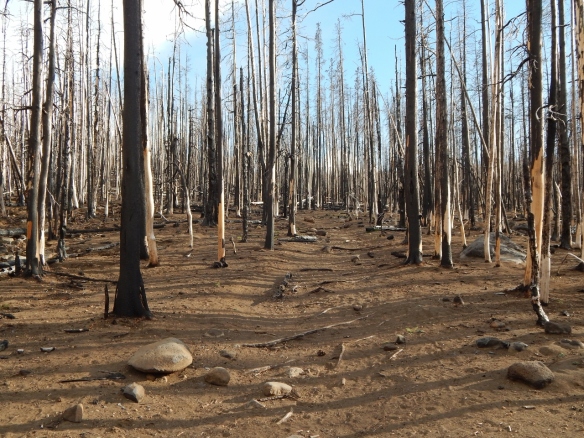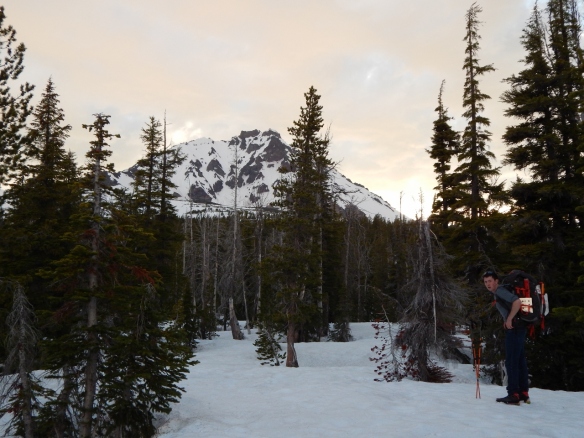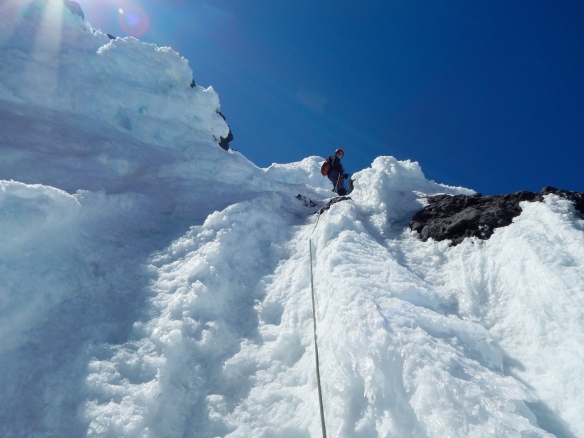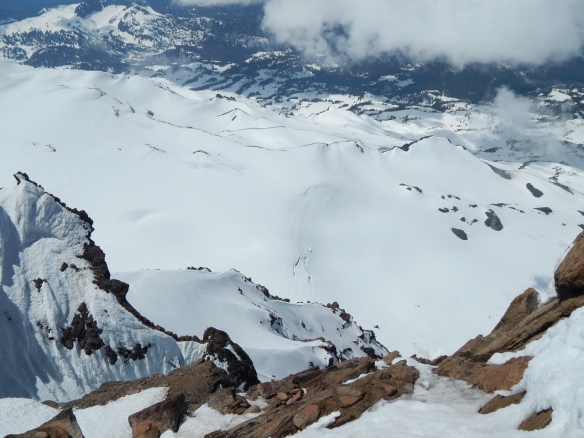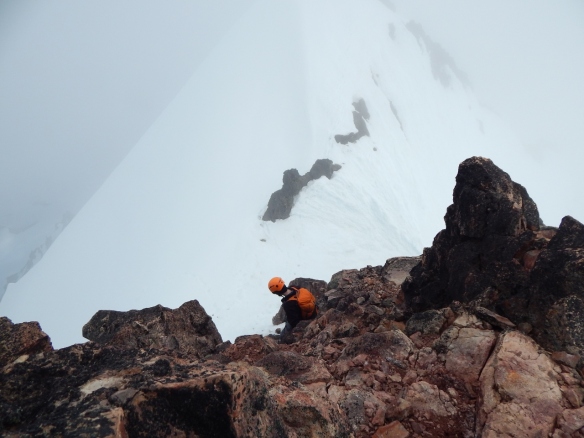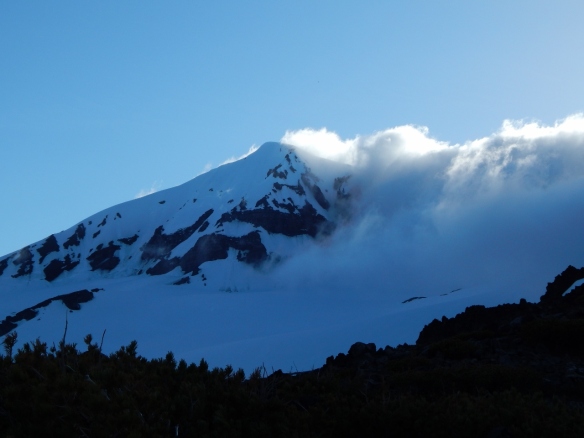On May 31st, my roommate Jonathan and I climbed North Sister, the second highest but easily the most difficult of the Three Sisters volcanoes near Bend, Oregon. North Sister, is officially Faith to Middle Sister and South Sister’s Hope and Faith, but many people have given it darker nicknames such as “the Sinister Sister,” “Ugly Sister,” or, most ridiculously “the Black Beast of the Cascades.” These nicknames are owed to the mountain’s much steeper and rockier terrain than the two other Sisters, as it is older and more eroded. This, in combination with the appallingly loose volcanic rock that makes up all of these mountains, means the North Sister is a rather difficult and dangerous mountain to climb compared to its neighbors.
Up to that point, I had done some roped climbing in the Cascades, on Mount Washington and Three Fingered Jack, but I wanted to combine that with sinking my new ice tools into something. I’d not ice climbed for a few years, and wanted to get back into it. With that experience, I decided that I was just barely ready to tackle the Sinister Sister.
Jonathan and I hiked in from the Pole Creek Trailhead on the evening of Friday the 30th, setting a high camp as it got dark on the snow slopes below the beginning of the southeast ridge.

South Sister. Unlike North and Middle Sisters, it is geologically young with an intact and relatively uneroded crater at its summit.
We got up at about 4:00 AM the next morning and reached the base of the southeast ridge by the time the sun rose, which made for a pretty good show. 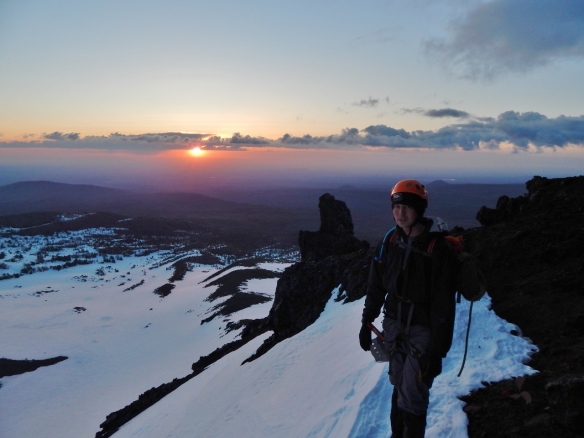
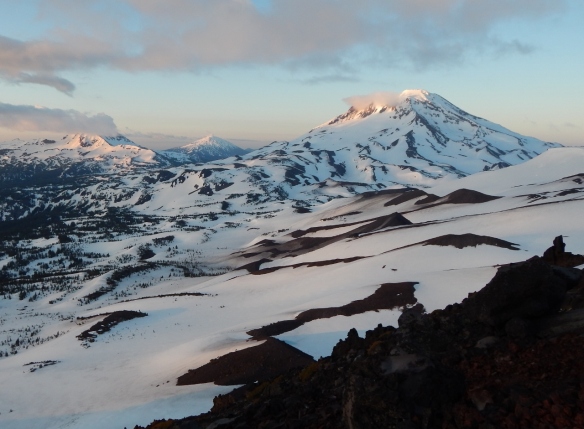
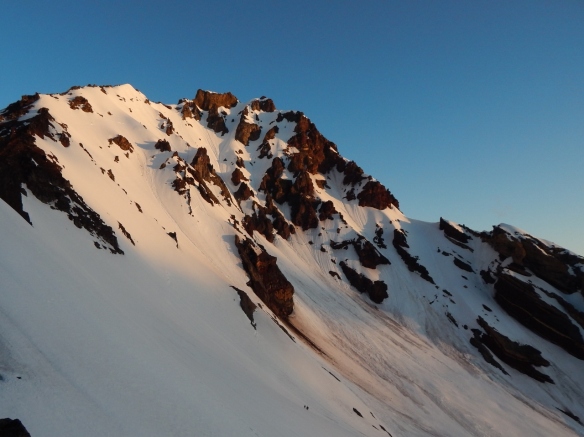
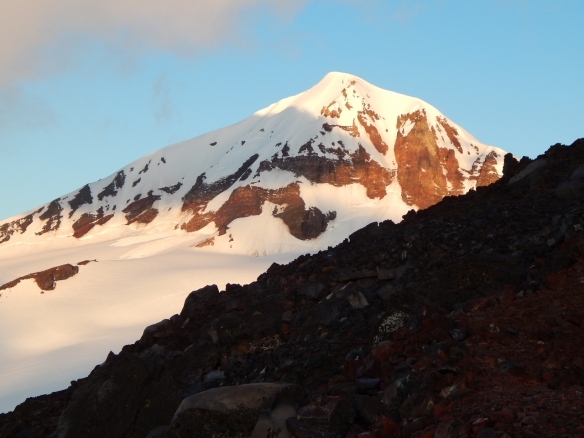 The southeast ridge ended up taking considerably longer than we thought it would. It was technically easy, but complicated and loose, and we underestimated its sheer size from its base, mostly likely due to foreshortening. To be honest, we were both also probably somewhat out of shape for that sort of thing. Steady but slow progress was made, however, and we enjoyed good weather and spectacular views until the start of the real business, the Terrible Traverse and the Bowling Alley.
The southeast ridge ended up taking considerably longer than we thought it would. It was technically easy, but complicated and loose, and we underestimated its sheer size from its base, mostly likely due to foreshortening. To be honest, we were both also probably somewhat out of shape for that sort of thing. Steady but slow progress was made, however, and we enjoyed good weather and spectacular views until the start of the real business, the Terrible Traverse and the Bowling Alley. We chose to pitch out the Terrible Traverse, which again took longer than expected because what I figured would be two quick pitches ended up being three pitches and some simulclimbing, which took perhaps a little bit over an hour. Conditions were good, and the firm snow made for solid picket and fluke placements. The bowling alley was icier, and due to our limited gear, we split it up into three very short pitches in order to avoid running it out on terrain that neither of us was very comfortable or familiar with. The climbing, however, was excellent and memorable, and I always felt solid despite the runouts. Jonathan ended up leading the crux bit in the middle, which was probably AI2 or 3, and about 70 degrees steep. We did learn our lesson here, however, and we now realize that in future climbs we would have to either be bolder and run things out more, bring more gear, or simply solo (on a later attempt on Jefferson, we opted for the second option).
We chose to pitch out the Terrible Traverse, which again took longer than expected because what I figured would be two quick pitches ended up being three pitches and some simulclimbing, which took perhaps a little bit over an hour. Conditions were good, and the firm snow made for solid picket and fluke placements. The bowling alley was icier, and due to our limited gear, we split it up into three very short pitches in order to avoid running it out on terrain that neither of us was very comfortable or familiar with. The climbing, however, was excellent and memorable, and I always felt solid despite the runouts. Jonathan ended up leading the crux bit in the middle, which was probably AI2 or 3, and about 70 degrees steep. We did learn our lesson here, however, and we now realize that in future climbs we would have to either be bolder and run things out more, bring more gear, or simply solo (on a later attempt on Jefferson, we opted for the second option).
We ended up reaching the summit at about 1:00PM, considerably later than we would have liked, but only a few minutes behind the party ahead of us. We spent about 15 minutes on the top, and then started down to beat the warming temperatures down as best we could. The Bowling Alley was easy to descend, and we did a combination of rappelling (painfully slow with only one 60m rope, as we watched another party with double ropes move much more quickly) and downclimbing. When we got back to the traverse, however, one of the many small clouds that had been floating about engulfed us and reduced the visibility to less than a rope length. The snow also became pretty sloppy, and I didn’t trust any of our snow anchors nearly as much as on the way up. Luckily, however, the climbing was fairly quick and easy, as large steps had been kicked into the entire traverse by multiple parties by then, making for fairly secure climbing for the most part. The most scary thing was actually the spontaneous rock and ice fall that began to strafe sections of the traverse as we were leaving it. It is amazing how fast this mountain is falling apart, and we were thankful when we got out of the rockfall zone and back onto the ridge.
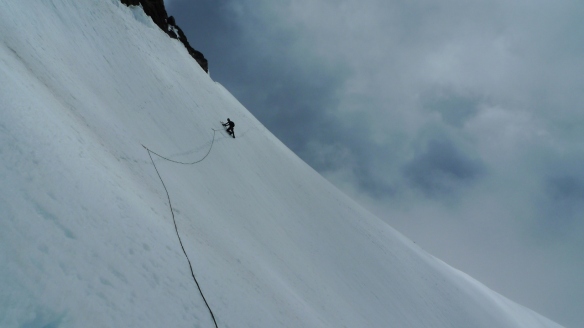
Me leading back accross the Terrible Traverse, right about at the point that there started being random small rockfall on the slope. Photo: Jonathan Perry-Houts.
The rest of our descent was uneventful if slow, and we made it back to camp in beautiful clear skies (only the very summit area of the mountain was socked in). Shouldering our heavy packs full of camping gear, we eventually made it back to the car just after it got dark.

Looking back towards the trailhead area from our high camp. It was a long, if blissfully downhill, five miles.
This was a very fun and very educational climb for me. More than anything, it taught me the importance of climbing more quickly, as our camp-to-camp time ended up being an absurd 14 hours, not including the approach hike. I think I can attribute most of this to a general lack of fitness, as the southeast ridge was slow and we took more breaks than we really should have, particularly on the way up. Second, a single 60 m rope did not make for a fast descent, and I will be using two skinny 50 or 60 m ropes on future climbs that require a lot of rapelling. My one regret is not being off of the Terrible Traverse sooner than we were, as things seemed to go downhill pretty fast once the cloud moved in at 1-2 PM. Overall, it was a good experience and I climb I will look back on fondly, and hopefully I won’t be too horrified by anything I did once I have more experience.

